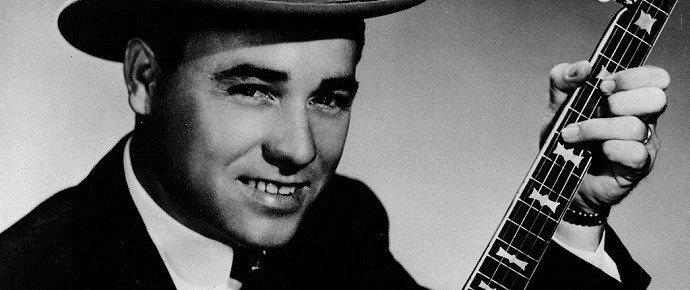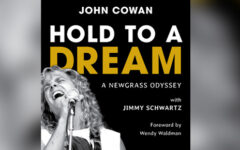
Earl Scruggs and his banjo playing prowess has been the subject of intense delight, interest, and discussion ever since he stepped onto the stage of the Grand Ole Opry with Bill Monroe in late 1945.
All of which has generated a good few books on Scruggs’ banjo playing over the past five decades or so and aficionados will be pleased to learn that learn of another – Earl Scruggs and Foggy Mountain Breakdown : The Making of an American Classic, by musician and music journalist of more than thirty years standing, Thomas Goldsmith.
Bluegrass Today spoke to Goldsmith to learn more about this work ……
“I heard Foggy Mountain Breakdown for the first time in about 1965, when I started listening to Flatt & Scruggs, Bill Monroe, and the Stanley Brothers in earnest.
Along with the rest of America, I became captivated by its energy and drive in the context of the 1967 movie Bonnie & Clyde.
The spark for writing this book came when Jim Mills told me that the 1949 recording of Foggy Mountain Breakdown kicked off his own interest in the banjo as a child, and that he still stops wherever he is to listen through when that track comes on, even through an eight-inch speaker in the ceiling of a late-night truck stop.
Originally, I planned to write about Foggy Mountain Breakdown as one of about 14 great songs in bluegrass, tunes that had become so popular that fans and pickers may have lost sight of what strong numbers they are.
When I interviewed Earl Scruggs on the tune in 2007, he said such interesting things that I realized that there was a whole book in the story of Foggy Mountain Breakdown. With that interview as the true starting point of this book, it’s taken me more than 12 years to complete the project, while involved in many other professional and personal matters.
I had the assistance of Mills, Bela Fleck, Sonny Osborne, Steve Martin, and several other top-flight banjo players in discussing the achievement of Earl Scruggs. In addition to detailed discussions of Foggy Mountain Breakdown and the evolution of Earl’s style, I’ve included information on the early years of bluegrass, on Earl’s interaction with Bill Monroe and Lester Flatt, on how Flatt and Scruggs’s career continued to thrive during hard years for bluegrass, on their involvement with The Beverly Hillbillies and Bonnie & Clyde, on the cult of the Mastertone banjo, and on Earl’s career after the breakup.”
Here is what the publisher, University of Illinois Press, has to say …
The breakneck banjo tune that became a song for the ages.
Recorded in 1949, Foggy Mountain Breakdown changed the face of American music. Earl Scruggs’s instrumental essentially transformed the folk culture that came before it while helping to energize bluegrass’s entry into the mainstream in the 1960s. The song has become a gateway to bluegrass for musicians and fans alike as well as a happily inescapable track in film and television.
Thomas Goldsmith explores the origins and influence of Foggy Mountain Breakdown against the backdrop of Scruggs’s legendary career. Interviews with Scruggs, his wife Louise, disciple Bela Fleck, and sidemen like Curly Seckler, Mac Wiseman, and Jerry Douglas shed light on topics like Scruggs’s musical evolution and his working relationship with Bill Monroe. As Goldsmith shows, the captivating sound of Foggy Mountain Breakdown helped bring back the banjo from obscurity and distinguished the low-key Scruggs as a principal figure in American acoustic music.
Passionate and long overdue, Earl Scruggs and Foggy Mountain Breakdown takes readers on an ear-opening journey into two minutes and forty-three seconds of heaven.
Two eminent authors in the bluegrass music field shared these brief reviews ……
“An enormous contribution to the history of bluegrass and a fascinating read, well organized and well told. Goldsmith’s lengthy interview with Earl is a treasure trove of information not only about Foggy Mountain Breakdown but about the early days of bluegrass and specifically Earl’s working relationship with Bill Monroe, which has long been clouded in mystery.”
Murphy Hicks Henry, author of Pretty Good for a Girl: Women in Bluegrass
“A fascinating read! Goldsmith tells how Earl Scruggs used his unique artistic vision to invent a musical language understood and embraced by performers and audiences alike, reviving the five-string banjo to leave an enduring mark on American popular music.”
Neil V. Rosenberg, author of Bluegrass Generation: A Memoir
Earl Scruggs and a host of elite banjo players at Camp Springs Bluegrass Festival in 1971 give Foggy Mountain Breakdown good work-out…..
[except from Bluegrass Country Soul]
Publishing details …..
University of Illinois Press
Publication date: October 2019
Pages: 184 pages
Dimensions: 6 x 9 in
Illustrations: 13 black and white photographs
Music in American Life Series
Cloth – 978-0-252-04296-6, Cost $99.00
Paper – 978-0-252-08478-2, Cost $19.95
Publication of this book was supported in part by a grant from the Judith McCulloh Endowment for American Music. https://www.american-music.org/page/McCullohFWP
Thomas Goldsmith is the editor of The Bluegrass Reader and the winner of the International Bluegrass Music Association’s (IBMA) Print Media Person of the Year award for 2004.







